
Combinatorics is an upper-level introductory course in enumeration, graph theory, and design theory.
- Subject:
- Mathematics
- Material Type:
- Textbook
- Provider:
- University of Lethbridge
- Author:
- Joy Morris
- Date Added:
- 12/14/2007

Combinatorics is an upper-level introductory course in enumeration, graph theory, and design theory.
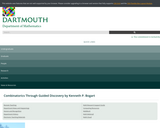
his book is an introduction to combinatorial mathematics, also known as combinatorics. The book focuses especially but not exclusively on the part of combinatorics that mathematicians refer to as “counting.” The book consists almost entirely of problems. Some of the problems are designed to lead you to think about a concept, others are designed to help you figure out a concept and state a theorem about it, while still others ask you to prove the theorem. Other problems give you a chance to use a theorem you have proved. From time to time there is a discussion that pulls together some of the things you have learned or introduces a new idea for you to work with. Many of the problems are designed to build up your intuition for how combinatorial mathematics works. There are problems that some people will solve quickly, and there are problems that will take days of thought for everyone. Probably the best way to use this book is to work on a problem until you feel you are not making progress and then go on to the next one. Think about the problem you couldn’t get as you do other things. The next chance you get, discuss the problem you are stymied on with other members of the class. Often you will all feel you’ve hit dead ends, but when you begin comparing notes and listening carefully to each other, you will see more than one approach to the problem and be able to make some progress. In fact, after comparing notes you may realize that there is more than one way to interpret the problem. In this case your first step should be to think together about what the problem is actually asking you to do. You may have learned in school that for every problem you are given, there is a method that has already been taught to you, and you are supposed to figure out which method applies and apply it. That is not the case here. Based on some simplified examples, you will discover the method for yourself. Later on, you may recognize a pattern that suggests you should try to use this method again.

This textbook is designed for beginning-intermediate English language learners. It is composed of 7 chapters, each of which covers specific speaking and listening learning objectives and includes dialogues, interviews, discussions and conversation activities. Each chapter includes listening and speaking components such as dialogues, interviews, discussions and conversation activities. Each chapter also focuses on 10 target words from the New General Service List of English vocabulary. The textbook includes an audio component that consists of recorded conversations of native and non-native English speakers, as well as links to additional listening resources on the web.
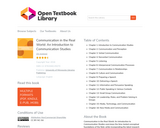
Communication in the Real World: An Introduction to Communication Studies overviews the time-tested conceptual foundations of the field, while incorporating the latest research and cutting-edge applications of these basics. Each chapter will include timely, concrete, and real-life examples of communication concepts in action. A key feature of this book is the integration of content regarding diversity and organizational communication in each chapter through examples and/or discrete sub-sections. Discussions of diversity are not relegated to feature boxes. Also integrated into the content are examples that are inclusive in terms of race, gender, sexuality, ability, age, marital status, religion, and other diverse identity characteristics.
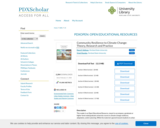
This reader is an Open Educational Resource, meant to accompany a graduate or higher-level undergraduate university course in climate change resilience, adaptation, and/or planning. While the material is geared toward students in urban and regional planning, it may also be of interest to students of urban studies, public health, geography, political science, sociology, risk management, and others.
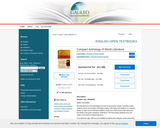
The introductions in this anthology are meant to be just that: a basic overview of what students need to know before they begin reading, with topics that students can research further. An open access literature textbook cannot be a history book at the same time, but history is the great companion of literature: The more history students know, the easier it is for them to interpret literature.
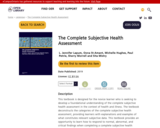
This textbook is designed for the novice learner who is seeking to develop a foundationalunderstanding of the complete subjective health assessment in the context of health and illness. The textbook deconstructs the categories of the complete subjective health assessment, providing learners with explanations and examples of what constitutes relevant subjective data. This textbook provides an opportunity to learn how to respond to normal, abnormal, and critical findings when completing a complete subjective health assessment
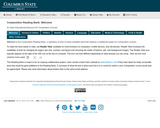
Composition Reading Bank is a repository of links to freely available texts that replaces a traditional reader for Composition courses.
This Reading Bank is meant to be an ongoing collaborative project; users should contact Nick Lakostik at nlakosti@cscc.edu if they have ideas for freely accessible texts that would be good additions to the Reading Bank. A summary of what the text is about and how it is or could be useful in your Composition course would also be appreciated. Please also send information about broken links to the same email address.
A link to this resource on the Columbus State Community College Library's web page is:
https://library.cscc.edu/compreadingbank
Except where otherwise indicated, the Composition Reading Bank by Rachel Brooks-Pannell, Shawn Casey, Rebecca Fleming, and Nick Lakostik at Columbus State Community College is licensed under Creative Commons Attribution-NonCommercial-ShareAlike 4.0 International License. This license does not extend to the contents of external web pages.
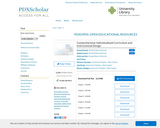
This online textbook addresses the population of individuals with disabilities that experience complex lifelong needs across multiple areas in their lives. Drs. Sennott and Loman drafted this book (along with the help from some friends) with the hope of providing pertinent, practical, and current resources to future special educators who plan to serve individuals with complex disabilities.

All of the mathematics required beyond basic calculus is developed “from scratch.” Moreover, the book generally alternates between “theory” and “applications”: one or two chapters on a particular set of purely mathematical concepts are followed by one or two chapters on algorithms and applications; the mathematics provides the theoretical underpinnings for the applications, while the applications both motivate and illustrate the mathematics. Of course, this dichotomy between theory and applications is not perfectly maintained: the chapters that focus mainly on applications include the development of some of the mathematics that is specific to a particular application, and very occasionally, some of the chapters that focus mainly on mathematics include a discussion of related algorithmic ideas as well.
The mathematical material covered includes the basics of number theory (including unique factorization, congruences, the distribution of primes, and quadratic reciprocity) and of abstract algebra (including groups, rings, fields, and vector spaces). It also includes an introduction to discrete probability theory—this material is needed to properly treat the topics of probabilistic algorithms and cryptographic applications. The treatment of all these topics is more or less standard, except that the text only deals with commutative structures (i.e., abelian groups and commutative rings with unity) — this is all that is really needed for the purposes of this text, and the theory of these structures is much simpler and more transparent than that of more general, non-commutative structures.
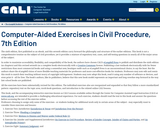
The sixth edition, first published as an ebook, and this seventh edition carry forward the philosophy and structure of the earlier editions. This book is not a comprehensive treatise on the subject of civil procedure, yet it provides a mixture of expository text, cases, and self-testing questions in nearly all of the major areas of the subject.

This open textbook aims to fill the gap between the open-source implementations and the open-source network specifications by providing a detailed but pedagogical description of the key principles that guide the operation of the Internet.
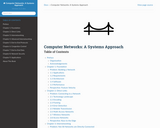
Suppose you want to build a computer network, one that has the potential to grow to global proportions and to support applications as diverse as teleconferencing, video on demand, electronic commerce, distributed computing, and digital libraries. What available technologies would serve as the underlying building blocks, and what kind of software architecture would you design to integrate these building blocks into an effective communication service? Answering this question is the overriding goal of this book—to describe the available building materials and then to show how they can be used to construct a network from the ground up.

This textbook covers the traditional introductory Computer Science I topics but takes a unique approach. Topics are covered in a language-agnostic manner in the first part with supplemental parts that cover the same concepts in a specific language. The current version covers C, Java, and PHP. This textbook as been used in several Computer Science I sections over multiple years at the University of Nebraska-Lincoln.
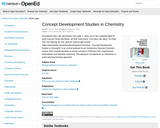
"Concept Development Studies in Chemistry" is an on-line textbook for an Introductory General Chemistry course. Each module develops a central concept in Chemistry from experimental observations and inductive reasoning. This approach complements an interactive or active learning teaching approach.
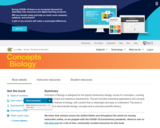
Concepts of Biology is designed for the introductory biology course for nonmajors taught at most two- and four-year colleges. The scope, sequence, and level of the program are designed to match typical course syllabi in the market. Concepts of Biology includes interesting applications, features a rich art program, and conveys the major themes of biology.
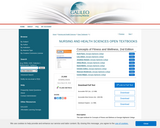
This open textbook for Concepts of Fitness and Wellness at Georgia Highlands College was created through a Round Seven ALG Textbook Transformation Grant.
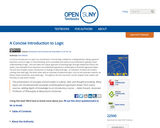
A Concise Introduction to Logic is an introduction to formal logic suitable for undergraduates taking a general education course in logic or critical thinking, and is accessible and useful to any interested in gaining a basic understanding of logic. This text takes the unique approach of teaching logic through intellectual history; the author uses examples from important and celebrated arguments in philosophy to illustrate logical principles. The text also includes a basic introduction to findings of advanced logic. As indicators of where the student could go next with logic, the book closes with an overview of advanced topics, such as the axiomatic method, set theory, Peano arithmetic, and modal logic. Throughout, the text uses brief, concise chapters that readers will find easy to read and to review.
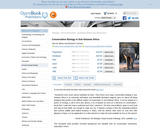
Conservation Biology in Sub-Saharan Africa comprehensively explores the challenges and potential solutions to key conservation issues in Sub-Saharan Africa.
Easy to read, this lucid and accessible textbook includes fifteen chapters that cover a full range of conservation topics, including threats to biodiversity, environmental laws, and protected areas management, as well as related topics such as sustainability, poverty, and human-wildlife conflict. This rich resource also includes a background discussion of what conservation biology is, a wide range of theoretical approaches to the subject, and concrete examples of conservation practice in specific African contexts. Strategies are outlined to protect biodiversity whilst promoting economic development in the region.
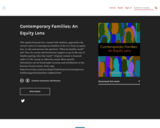
This openly licensed text, created with students, approaches contemporary families from an equity lens. It asks two questions relevant to the Difference, Power, and Discrimination outcomes at Linn-Benton Community College and Oregon State University: “What do families need?” and “How do society and institutions support or get in the way of families getting what they need?" Original content is licensed under CC BY, except as otherwise noted. More specific information can be found under Licenses and Attributions at the bottom of each section.